
Posted by
Shay Harel
Did you blink? Because if you did you may have missed Google’s clandestine algorithm update that mystified not only the SEO industry but every single rank fluctuation weather tracker! What happened and how did the tools all miss this one? How impactful was this stealth update? What did it have to do with local results?
We’ll cover the latest update incarnation as well as changes and tests to the SERP that brought Google’s travel domination to all-new levels, kicked Featured Snippet URLs out of the organic results, and gave recipe hunters one less reason to click on your site!
It’s on. Welcome to the December edition of the SERP News!

Getting the Scoop on November’s Stealthy Google Algorithm Update
On November 11th, reports of a Google update hitting the SERP started rolling in. SEOs of all sorts started taking to Twitter showing all sorts of wild ranking losses typical of your average Google update. Yet, despite all the ranking noise within the industry, our Rank Risk Index that measures rank fluctuations was quiet and so were all of the other “weather tools.”
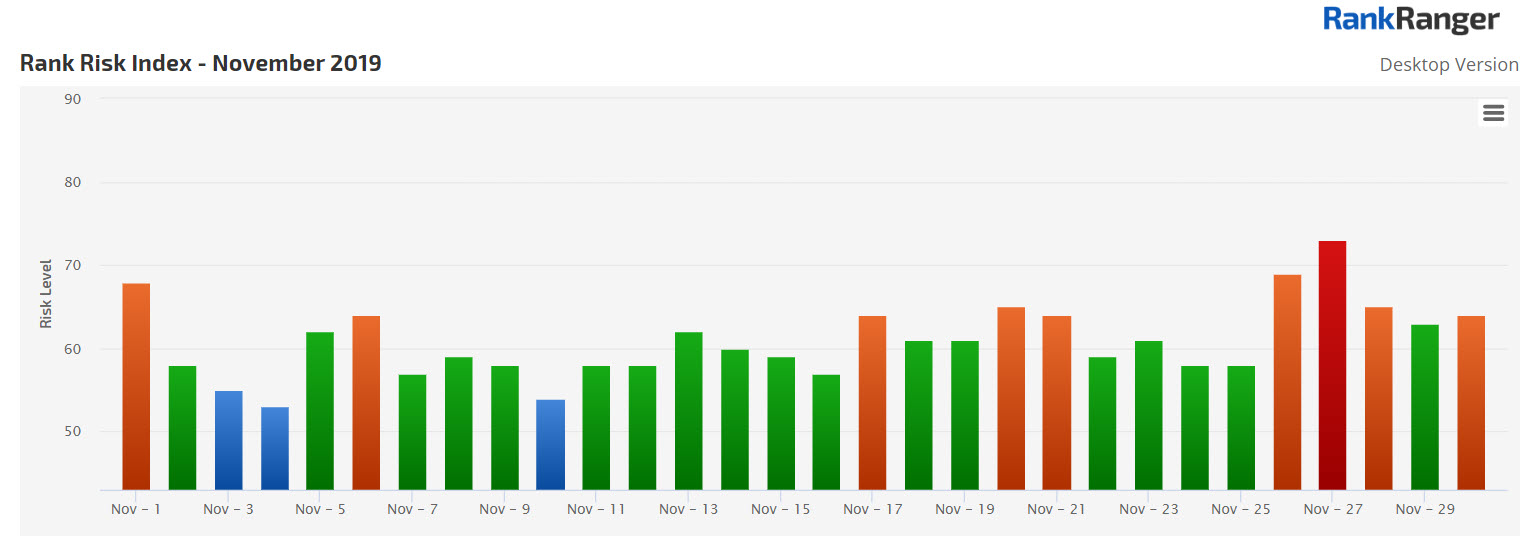
The complete set of rank fluctuations picked up by the Rank Risk Index in November
How could that be? How could it be that there were so many folks seeing such drastic changes in rank without any of the tools picking it up? Pretty bizarre.
On a recent episode of The In Search SEO Podcast I mentioned that we did a bit of brainstorming around this. While there were certainly a lot of big rank shakeups, the overall movement was very gradual. That is, we saw a lot of sites moving up/down a position or two over a 2 – 3 day period. That sort of progressive rank movement makes for a more stealth-like Google update. A rank fluctuation weather tool tracks fluctuation increases by analyzing the current rank volatility levels to those exhibited on the SERP in the recent past. If the overall fluctuation levels were very gradual, it would take some time for such tools to recalibrate and become sensitive to that sort of progressive rank movement. Hence, this could be why the tools did not pick up on this update as they usually do.
Google backhandedly admitted that November has been oddly volatile when John Mueller said he did not think “links” to be behind the ranking adjustments. This volatility continued as November waned with the Rank Risk Index showing high levels of rank volatility as of November 27th. It was certainly quite an odd month for rank volatility, that is for sure.
The November ‘Stealth’ Update and Result Chunking
Yes, you’ll notice in the H3 above, I have dubbed this the ‘November Stealth Update.’
Now, being that we did not analyze enough data for me to call this conclusive, the above is not conclusive, though it makes good sense. It makes even more sense when you consider the timing of the update relative to another change to the SERP.
On November 12th, as in one day after the Stealth Update was unearthed and still in progress, folks started to notice that Google was chunking results from the same domain (where a domain had multiple page one results) together in one ‘card’ on mobile. That is, instead of one of the domain URLs ranking say #3 and another #10 on the SERP, Google combined them by placing both results within one mobile card.
While this was first seen on mobile, the same is also happening on desktop. And despite the initial reports showing such result “chunks” to be hard to find they seem far more common at this point.
And this has to do with the Stealth Update how exactly?
Easy, Google chunking a domain’s page one URLs means a decent amount of micromovements and less severe ranking movements (i.e., pages moving 7 positions as opposed to 70) were made at the exact same time that the Stealth Update hit the SERP. Coincidence? Seriously? No!
The Release of the November 2019 Local Update
There’s another constituency who weighed in on Google’s clandestine update. Local SEO great Joy Hawkins dubbed this update the Bedlam Update stating that the local world also saw large amounts of rank volatility.
Per Joy, the local SEO world saw significant rank changes circa November 5th with the fluctuations seen closer to mid-November representing a reversal (or an accentuation of previous gains/losses). Further, the update seemed to hone in on local relevancy with Google showing local sites for queries that were not reflective of their primary business category.
Joy very much seems to have been correct because on December 2nd Danny Sullivan announced the November 2019 Local Update. Per Danny, Google had been applying neural matching to local results since early November. This would explain why the update focused on relevancy vs. proximity (as neural matching has nothing to do with proximity per se). The implementation of neural matching on the local front could have helped contribute to the weather tools missing this update as such changes may have been quite nuanced.
That said, I don’t think all of the ranking movement seen during the month was related to the November 2019 Local Update as the sites that showed great volatility were not relegated just to local verticals. It’s worth noting that Google has often said it piggybacks multiple changes with the roll-out of a significant algorithmic change. Just another reason to call the “non-local” aspect of the update, the Stealth Update!
The SERP Roundup for November 2019
Major tests and changes to the Google SERP came our way in November! From Google offering lessons on pronunciation to the possibility of Google abandoning its Reserve with Google partners… here’s all that hit the SERP over the course of the month.
Local SEO Updates: From Hotel Filters to Local Pack Image Carousels
With a bunch of interesting tests, changes, and some downright juicy gossip coming out of Google’s local realm, November was a serious month for local changes.
More Hotel Filters and Travel Planning Features
More hotel filters have been added to Google’s trip planner site. Towards the end of November, some SEO folks starting reporting on new filters and booking features on Google’s travel site (which is usually accessed via the Local Pack and the like).
For instance, there is now a set of hotel selection filters entitled Where to stay, When to visit, and What you’ll pay.
These features offer a plethora of information to users. For example, under the Where to stay filter you will see a city’s top neighborhoods with a description of each area along with top attractions within it as well. The area will be reflected on the accompanying map, as it is below:
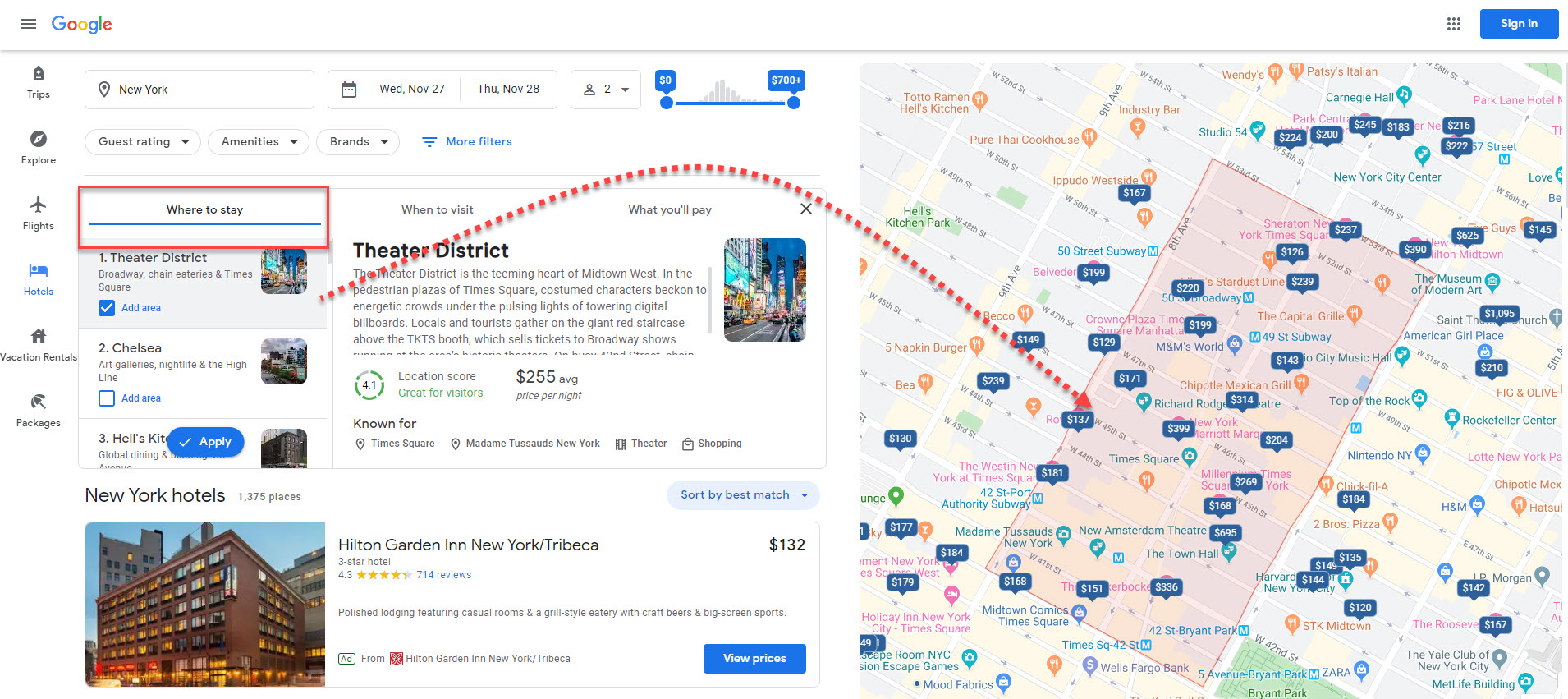
The When to visit filter offers information on the average temperature of the location on a per month basis. The information here also includes how bustling a city is with tourists each month and how expensive the hotels tend to be in general:
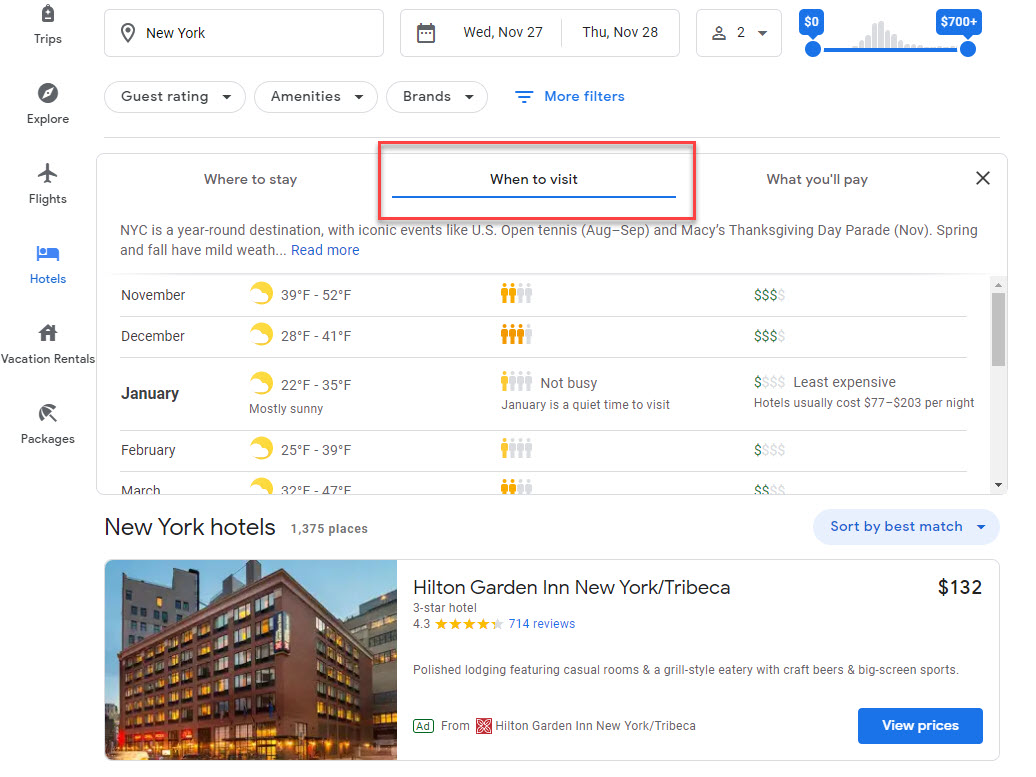
Lastly, the What you’ll pay feature indicates the average price of a hotel within a location on a “star-rating” basis:
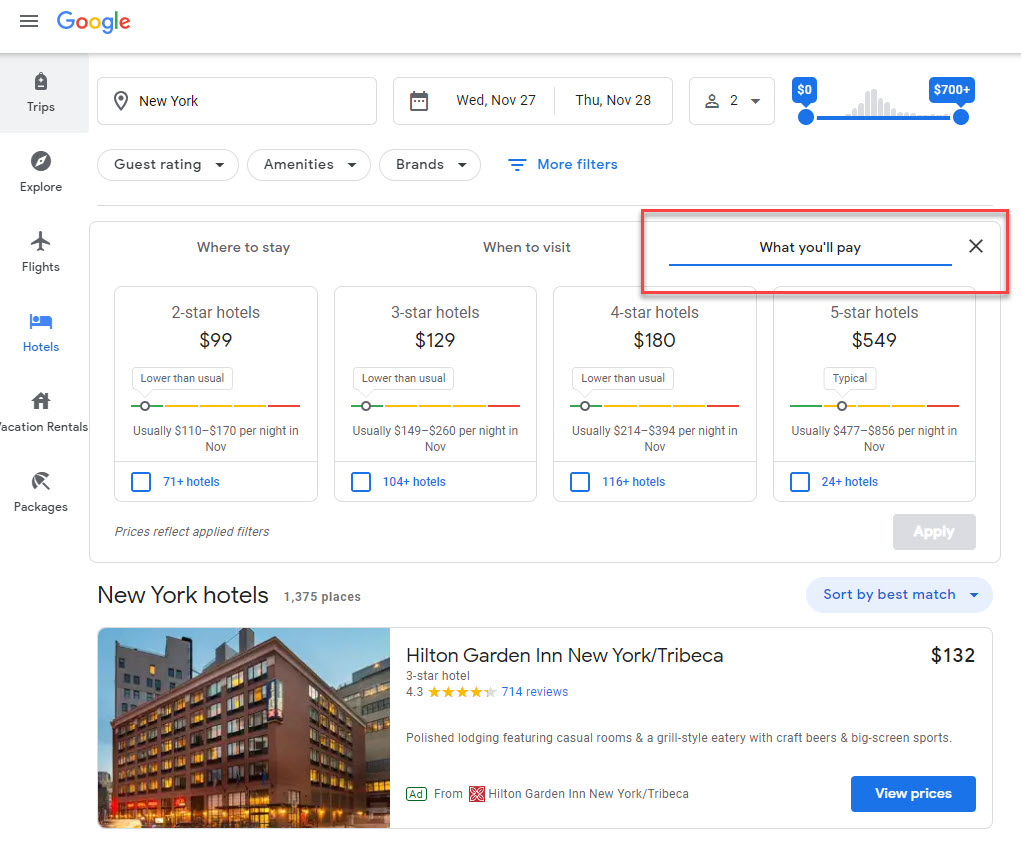
All-in-all, the new filters represent a TON of new information to help steer users towards the best lodging options available. That said, the timing could not be worse for travel sites as November saw Expedia’s stock take a hard hit with some attributing it to Google’s focus on travel info.
At the same time, it also seems that Google is more heavily testing a new section within its travel site offering hotel and flight packages with some markets obtaining the section and some not. This is very similar to what the traditional travel sites offer when they allow you to search for a flight and hotel together.
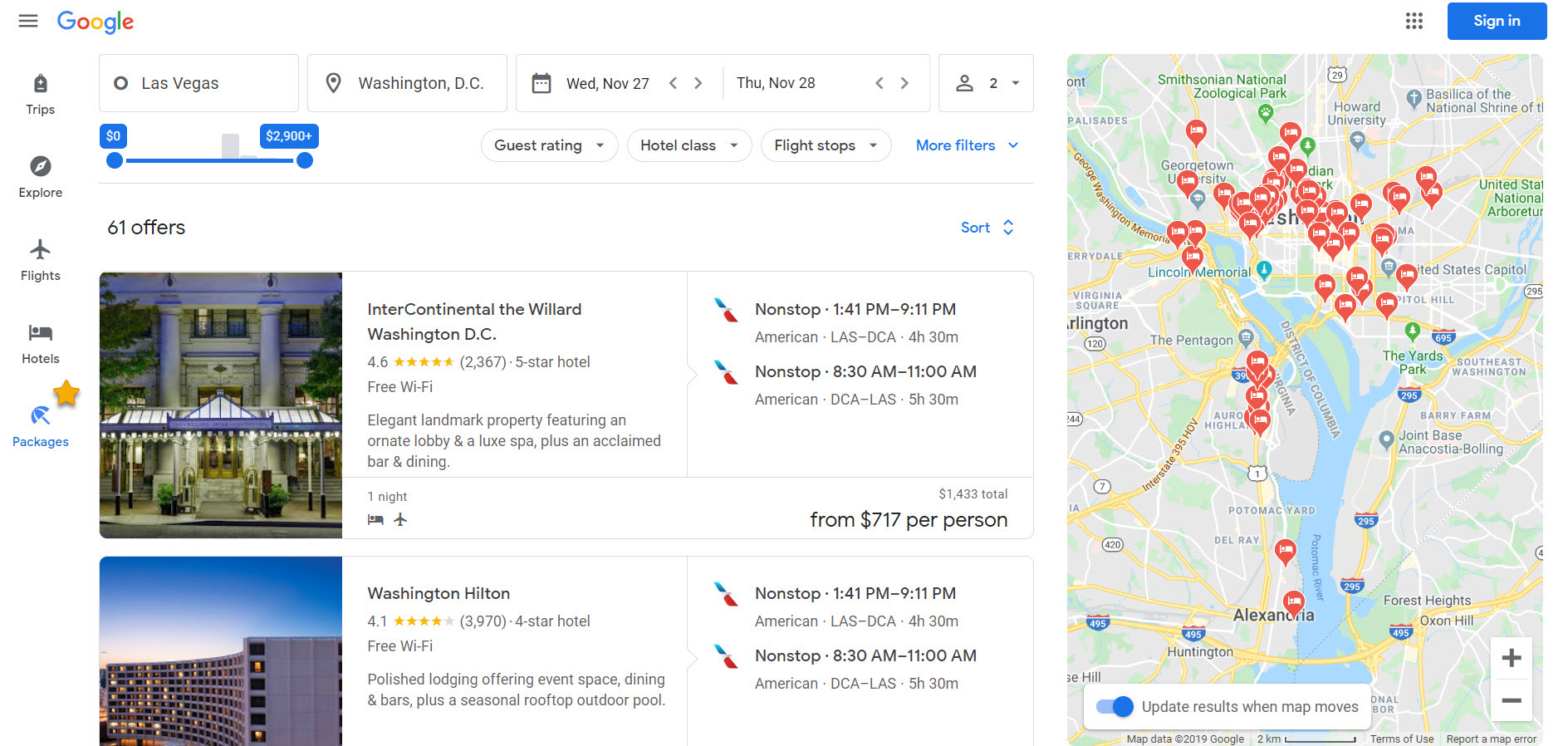
Google’s travel site offering a combination of flights and hotels as part of one travel package
Local Pack Image Carousels
An early November test had Google running image carousels within its Local Pack. The experiment presented a carousel of product images appearing beside each Local Pack listing. In the case found, which reflected a restaurant, I would imagine the images to be quite influential on user behavior. As opposed to a typical situation where the user would find images only after clicking on a listing (and subsequently reaching the listings business panel) these images offered users an instant look at how appetizing the establishments seem to be.
Could Google Be Throwing Its ‘Reserve with Google’ Partners to the Wind?
The Reserve with Google program, which lets you do things like book a table at a restaurant via the Local Panel, may be headed for a major change. Local SEO expert Mike Blumenthal noticed that within Google My Business the search engine was listing itself as a booking provider. The move would be a major shift in the current local landscape. Such a change could mean that Google would charge businesses directly for the service which is something I’ve been saying is coming for a long time now. That’s why, to me at least, Google moving on from its providers (either partially or completely) makes a good deal of sense.
The Dictionary Box Gets Dynamic
Two really interesting changes to Google’s Dictionary Box SERP feature. The first has images being added to certain dictionary results. From what I can see the images only tend to appear for simple nouns and for some very basic verbs. I guess for an English language learner the images will be helpful.
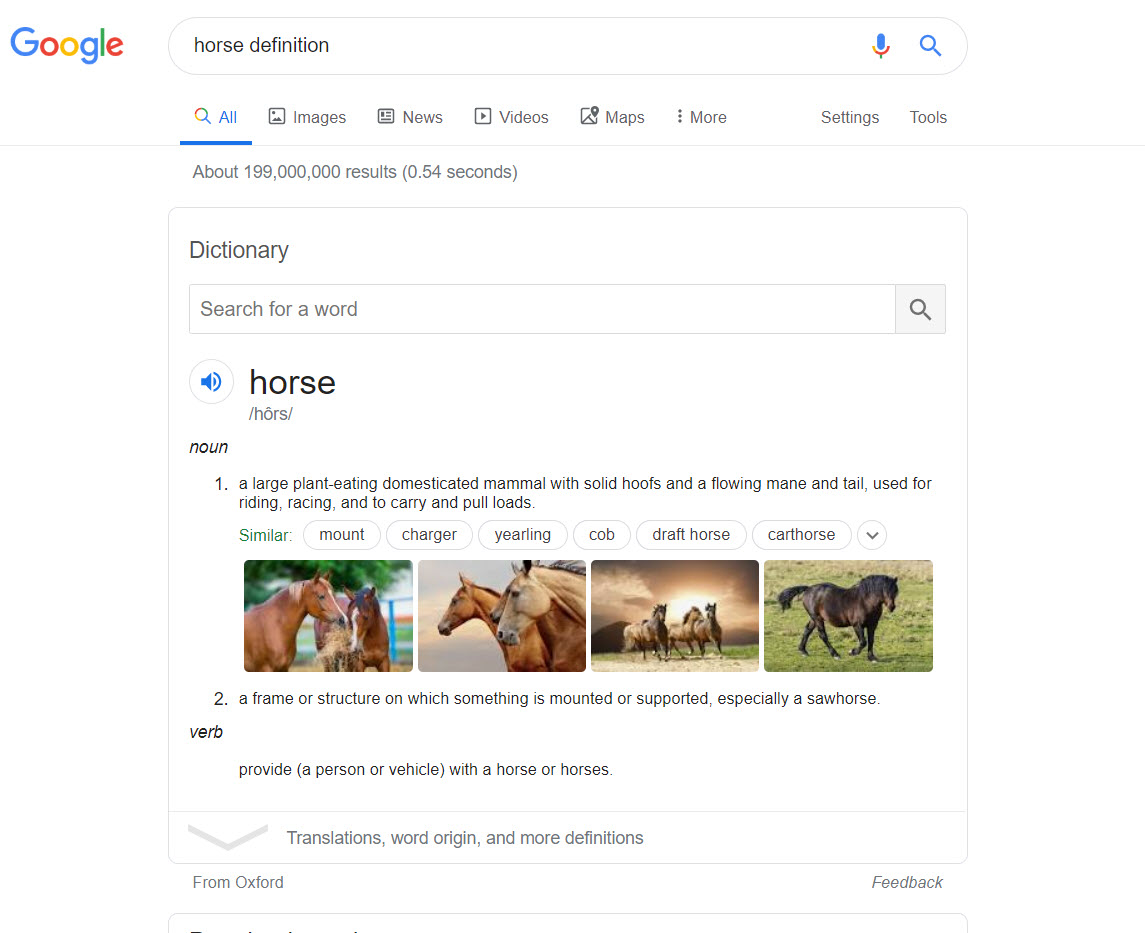
Google’s Dictionary Answer Box showing images that when clicked on enlarge to overlay the SERP
Also helpful to English language learners, Google has given the Dictionary Box the power of AI! Users can record their pronunciation of a word with Google offering feedback.
Here’s a look at the element’s performance when I decided to try out my best imitation of my father’s Brooklyn accent:
Look what I found (& decided to mess with)…. Google’s new pronunciation corrector thing-a-ma-bob!
Still needs a bit of work… #SEO pic.twitter.com/P59egXmsr6
— Mordy Oberstein (@MordyOberstein) November 20, 2019
Recipe Previews for Fewer Clicks?
Spotted on the November SERP was a test offering users one less reason to click on a site’s URL. In this instance, mobile recipe cards were spotted with a preview button. Utilizing the preview brought up a card that showed some basic information on the recipe, such as the ingredients. The preview card did have a CTA telling users to head over to the associated website. That said, these sorts of features conjure up all sorts of “clickless fears.”
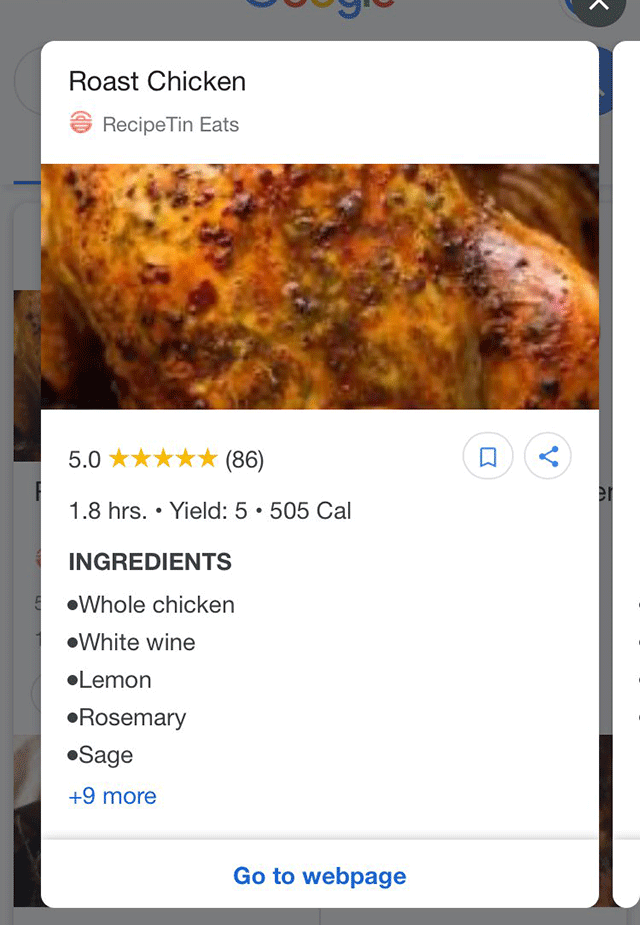
A preview overlay for a recipe that was tested on the SERP in November (Image Source: SERoundtable.com via Sergey Alakov)
In this instance, I would argue the fears are not unsubstantiated. Without the preview, the user had to head over to the site to see the required ingredients and who knows how a site may entice the user to stay and utilize the recipe. With the preview, a user may simply move on based on seeing the necessary ingredients.
Recipe Rich Result Bug Persists
Since early November, Google has had a difficult time consistently showing the image thumbnail that generally accompanies recipe rich results. This means that when you search to make Aunt Shirley’s famous pecan pie you won’t see a mouthwatering image coercing you to click in many instances.
As of the great culinary event known as Thanksgiving, the bug had yet to be fixed (and is still not fixed as of this writing to my knowledge). The only recourse you have, if affected, is to have Google recrawl your pages and index them via the Google URL Inspection Tool. Good luck doing that at scale.
Google Ads Tests a Comparison Tool & the Colorless Ad Label
Here’s a crazy one for you… Google Ads was found testing a rental car comparison tool. The whole thing is a bit peculiar. The tool, which I have not been able to replicate seems to let users compare car rental prices from different vendors.
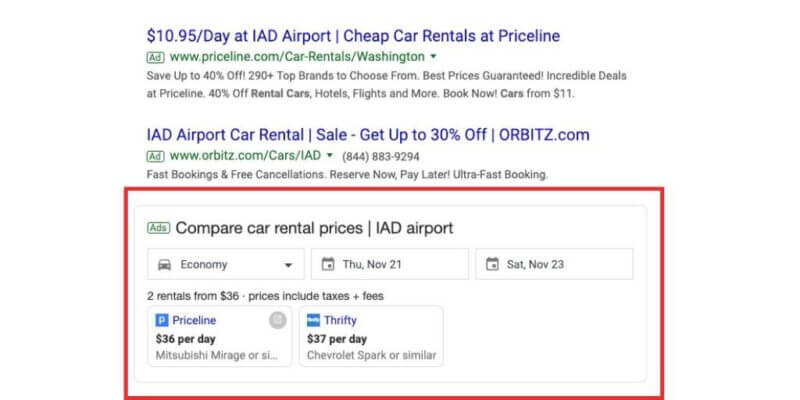
A Google Ad that consisted of a car rental comparison tool (Image Source: SearchEngineLand.com via SEMRush)
Looking at the ad featured above, a site like rentalcars.com must have paid for the tool/ad to appear as that’s the only way it makes sense to me. (Why would a specific rental company want to introduce its competitors?) Either way, the test is everything from bizarre to terrifying!
Shortly after the “car rental tool test” some folks started seeing Google testing its colorless ad label on desktop. Currently, the format used for mobile, the colorless ad label, is not used on the desktop SERP. That said, I saw the test myself on November 25th for the keyword hotels nyc:
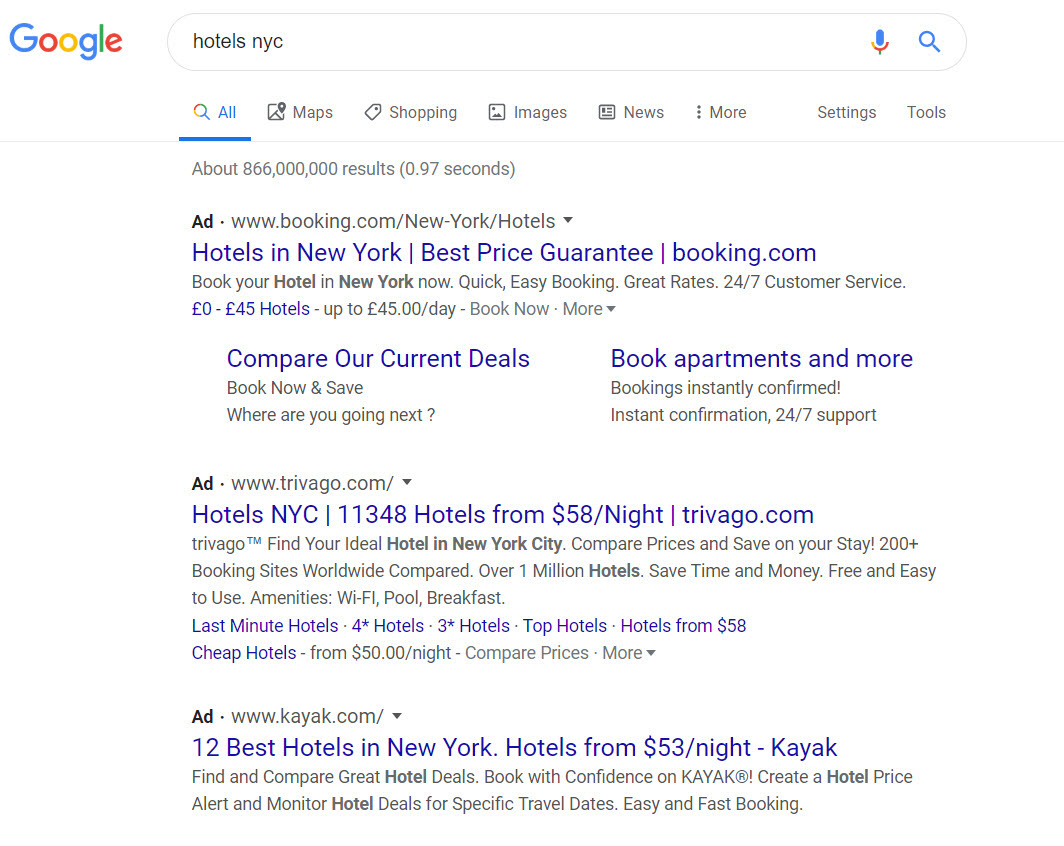
Oddly enough, I also saw Google testing favicons on the desktop SERP on the same day. Favicons are also a mobile-exclusive and were added to the mobile SERP at the same time as the colorless ad label (so it makes sense I would see both tested within hours of each other).
![]()
Favicons being tested on the desktop SERP along with colorless ad labels
No Organic Listing for Featured Snippet URLs
In what was perhaps the most disturbing test of the month, Google was seen not showing the URL used within a Featured Snippet among the organic results. Typically, the URL used within a Featured Snippet is also shown among the top organic results. Not so here. One can only hope this does not become a pattern.
Example: Legal & General in the featured snippet, and their actual ranking URL has been removed from the SERP entirely pic.twitter.com/Zy17NazLkf
— Kieron Hughes (@kieronhughes) November 12, 2019
You can start freaking out now or you could call this for what it probably was… a bug.
Image Clicks Bug
Did you notice fewer clicks coming from Google’s Image SERP between November 15th and 19th? If yes, you may be the victim of a Google bug! Google confirmed a bug that saw the search engine lose image click data over a five-day period. Meaning, don’t fret, you didn’t really lose any clicks/traffic. The only thing lost was the data itself.
Arrows Point to Search Result Titles
Here’s an odd idea… little blue “arrows” indicating titles on the SERP. Yet, that is exactly what Google tested on November 26th, arrows pointing to titles on the SERP. Spotted by Sergey Alakov and Valentin Pletzer, these little arrows are…. hideous. Yet, Sergey has an interesting theory, the arrows, which appear within an ad as well, make the organic results and ads look more uniform!
Google is testing little arrows in search results. The arrwos clearly point to listing titles and away from URLs and Ad lables. Imho, this is aimed at increasing ads’ CTR. cc:@rustybrick pic.twitter.com/TaGuR8zwyz
— Sergey Alakov (@sergey_alakov) November 26, 2019
Progressive Google Update Rollouts – A Sign of the Times?
Whether it happened this time around or not, the idea of a gradual release of a progressive Google update roll-out is a natural offshoot of Google’s more nuanced understanding of everything from user intent to web content itself. The more nuanced Google’s perception becomes the more nuanced the adjustments to the rankings will be (all things being equal). The idea of a consistent barrage of minute ranking movement seems inevitable to me. (I’m obviously not talking about the continuous changes to the rankings that take place currently – I mean something well beyond this in volume). From a user’s perspective, having more “real-time adjustments” (sort to speak) to the rankings is a net positive. The only question in my mind is how much would this cost Google in terms of its resources? Though, Penguin now functions in real-time making the notion of an unprecedented amount of continuous ranking changes a real possibility to me.
Who knows… maybe next month’s SERP will help shed light on this development! (A not so subtle plug to come back for next month’s edition of the SERP News!)




